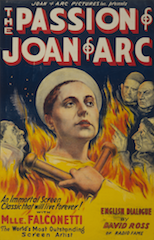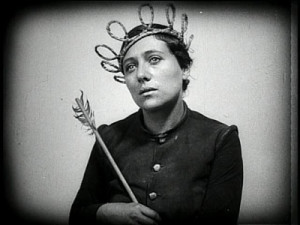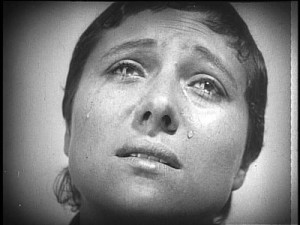 The movie theaters of today can be a cavalcade of senses. Besides the obvious images that move across the screen, we hear the musical score, we feel the ground shake during a big explosion, or we can even go to those 4D theaters and get misted with water or smell the sweetness of a flower. We even engage our sense of taste with butter-blasted, salty popped corn and delicious, sweet Raisinets (mmm…Raisinets).
The movie theaters of today can be a cavalcade of senses. Besides the obvious images that move across the screen, we hear the musical score, we feel the ground shake during a big explosion, or we can even go to those 4D theaters and get misted with water or smell the sweetness of a flower. We even engage our sense of taste with butter-blasted, salty popped corn and delicious, sweet Raisinets (mmm…Raisinets).
The era of silent film was a completely different experience and Carl Th. Dreyer’s Le Passion de Jeanne d’Arc is the height of sensory deprivation for the modern movie audience. For those of us reared on the titanic blockbusters of Star Wars, Jurassic Park, and Harry Potter, the stripping of all but the visual mise-en-scéne of Dreyer’s film is a potentially maddening experience. Dreyer hated scoring his movies with music and his eschewing of normal conventions fits right in line with the theater and artistic auteurs of 1920’s France—the movie was released during the pinnacle of the French avant-garde movement.
The copies of this movie had long thought to have been lost and destroyed. In fact, upwards of 70% of silent era films have been ill-kept, destroyed, or lost. Any existing copies of films were often of poor quality, e.g. the pre-restored copies of A Trip to the Moon, and Dreyer’s masterpiece had been a spliced up copy of a copy. In 1981, however, film canisters were found at a mental institution in Oslo and sent to the Norwegian Film Institute where in 1984 those canisters were discovered to contain the pre-church and government censorship copy of The Passion of the Joan of Arc. The Criterion Collection DVD of this movie opens with this story to go along with its bevy of features.
The circumstances of the movies miraculous return are as interesting as the films beginnings. Passion was Dreyer’s first major project where French producers had given him the freedom and sizable budget to do what he wanted. Dreyer chose Joan of Arc to be his first subject of a major production. Like many Frenchmen of the time, Dreyer had become fascinated with the saintly heroine of France. She was “The Maid of Orleans”; who had led the French to victory over British forces in 1428 and executed for heresy in 1431, and recently canonized by the pope as a saint in 1920. Dreyer set out to tell the story of Joan’s trial and execution and had spent many years researching his subject. A collaborator had once quipped that Dreyer prepared for a movie like a professor or doctoral candidate studied for a thesis paper.
Initially, he had been given a script to use for the film, but he discarded it and instead chose the transcripts of Joan’s 18-month trial and condensed it into one inquisition for the film. It was a bold choice to have the actors recite the lines in their totality, but it was a risk that paid off handsomely to give the dialogue a historical faithfulness.
But not only would the dialogue help it feel like a slice of history on-screen, but the technical elements of Dreyer’s craft enhanced the feeling of watching something like a dream or a memory Joan passed on for all of us to see. A prominent feature of the film that many reviewers and analysts have pointed out is the lack of establishing shots in the film. Dreyer never lets the camera pan out to give us a sense of time, place, or direction. The lack of establishment leaves the film in close intimacy with both Joan and her accusers and keeps the audience engaged full throttle from beginning to end. Also, few objects carry over from shot to shot, giving us no sense of coherence or visual links. As Roger Ebert states in his Great Movie series on this film, “There is a language of shooting and editing that we subconsciously expect at the movies. We assume that if two people are talking, the cuts will make it seem that they are looking at one another,” and Ebert says this creates a “fearful intimacy” between the judges and Joan, and we are witnesses to it.
On top of the bewildering edits, there is the earnest and masterful performance of Maria Falconetti as Joan of Arc. Widely believed to be the greatest performance in cinematic history, Falconetti communicates more with her eyes and facial expressions than many modern actresses do with dialogue, music, and makeup. She agonizes over every silent piece of dialogue; gushing pain, anguish, and inner turmoil that wrenches your heart yet forces you to watch. And those eyes, full of pain and tears, some of which was genuine. Dreyer was an extremely intense man and stories go that he exhausted Falconetti by having her kneel on the stone floor and do take after take to leech out the actor and draw out discomfort and pain. And all of the camera’s angles look down menacingly on Joan adding an element of nightmarish suffering and hellish discontent.
 Ultimately, one wonders what Dreyer wanted to convey in his film. One might say that it drums up our sympathy and draws us into Joan’s experience to empathize with this sincere maiden who endured the barbs and contempt of sneering, supercilious clergymen. However, the “fearful intimacy” Ebert saw between Joan and her captors create a natural barrier to us actually experiencing what Joan experienced.
Ultimately, one wonders what Dreyer wanted to convey in his film. One might say that it drums up our sympathy and draws us into Joan’s experience to empathize with this sincere maiden who endured the barbs and contempt of sneering, supercilious clergymen. However, the “fearful intimacy” Ebert saw between Joan and her captors create a natural barrier to us actually experiencing what Joan experienced.
Matthew Dessem of the Criterion Contraption argues Dreyer intentionally created this distance to convey a sense that we are all headed to the same place; a momento mori narrative. While I wouldn’t go that far, as I see very significant spiritual elements to the film, Dessem has a great last word to end his analysis: “The Passion of Joan of Arc is the rarest of films, the kind whose violence does not desensitize, but instead raises sensitivity to an unbearable pitch.”
What strikes me as the most enduring meaning of The Passion of Joan of Arc is that the spectacular emotion of the film makes us acutely aware of both our mortality as well as our immortality as spiritual creatures. It activates our humanity to sympathize with Joan’s suffering, to have compassion, but also activates our faith to trust in something beyond our moment(s) of trial and pain. There are hope and true life hiding behind the face of suffering and tears.


This review makes me even more excited to see it. It’s definitely on my list!
That makes two of us!
There is NO sound. It’s crazy. I thought my computer was broken at first until I read some of the Criterion stuff on it. It might be interesting to watch this on YouTube that someone has put a soundtrack over. I have heard one scoring is incredibly powerful, but I can’t remember what it is. One of the essays I read referenced it.
I heard at the 2016 TCM Classic Film Festival they had a live orchestra and vocalists to accompany the screening of this. Must have been pretty impressive! http://bit.ly/29nHS0W